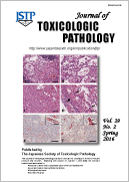Volume 29, Issue 2
Displaying 1-12 of 12 articles from this issue
- |<
- <
- 1
- >
- >|
In Memoriam
-
2016Volume 29Issue 2 Pages 75
Published: 2016
Released on J-STAGE: May 11, 2016
Download PDF (150K)
Original Articles
-
2016Volume 29Issue 2 Pages 77-84
Published: 2016
Released on J-STAGE: May 11, 2016
Advance online publication: December 07, 2015Download PDF (723K) -
2016Volume 29Issue 2 Pages 85-93
Published: 2016
Released on J-STAGE: May 11, 2016
Advance online publication: January 18, 2016Download PDF (3413K) -
2016Volume 29Issue 2 Pages 95-102
Published: 2016
Released on J-STAGE: May 11, 2016
Advance online publication: January 24, 2016Download PDF (11695K) -
2016Volume 29Issue 2 Pages 103-110
Published: 2016
Released on J-STAGE: May 11, 2016
Advance online publication: February 12, 2016Download PDF (453K)
Case Reports
-
2016Volume 29Issue 2 Pages 111-114
Published: 2016
Released on J-STAGE: May 11, 2016
Advance online publication: January 15, 2016Download PDF (2368K) -
2016Volume 29Issue 2 Pages 115-118
Published: 2016
Released on J-STAGE: May 11, 2016
Advance online publication: February 15, 2016Download PDF (3053K) -
2016Volume 29Issue 2 Pages 119-124
Published: 2016
Released on J-STAGE: May 11, 2016
Advance online publication: February 25, 2016Download PDF (4987K)
Short Communications
-
2016Volume 29Issue 2 Pages 125-129
Published: 2016
Released on J-STAGE: May 11, 2016
Advance online publication: December 12, 2015Download PDF (2963K) -
2016Volume 29Issue 2 Pages 131-138
Published: 2016
Released on J-STAGE: May 11, 2016
Advance online publication: January 17, 2016Download PDF (3073K) -
2016Volume 29Issue 2 Pages 139-144
Published: 2016
Released on J-STAGE: May 11, 2016
Advance online publication: February 12, 2016Download PDF (1688K)
Erratum
-
2016Volume 29Issue 2 Pages 145
Published: 2016
Released on J-STAGE: May 11, 2016
Download PDF (442K)
- |<
- <
- 1
- >
- >|
